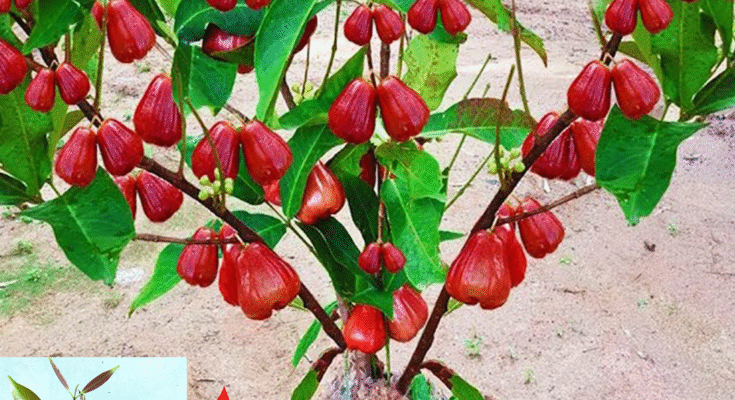New Techniques for Reproducing Rose Apple Tree from Rose Apple Fruit to Get Fruit Fast 100%
The rose apple, also known as Syzygium jambos, is a tropical fruit tree prized for its crisp, aromatic fruits and glossy green foliage. Many gardeners love this tree not only for its sweet, refreshing fruit but also for its ornamental value. Traditionally, rose apple trees are propagated through seeds, but this method often results in trees that take several years to bear fruit and sometimes fail to produce true-to-type fruit. Nowadays, gardeners are eager for faster, more reliable ways to grow rose apple trees that will guarantee high-quality fruit production in less time. This article will explore new techniques for reproducing rose apple trees from rose apple fruit, helping you get delicious fruit faster — with a near 100% success rate.
One of the most promising techniques for reproducing rose apple trees is using seeds combined with advanced preparation and grafting methods. Although growing from seed is the most straightforward approach, it can be improved by selecting only the best, fully ripe fruits. Choose healthy, disease-free rose apples and carefully extract the seeds. Wash them gently to remove any pulp that could cause fungal infections. To enhance germination, soak the seeds overnight in lukewarm water. This softens the seed coat and triggers faster sprouting.
However, the real innovation comes in combining seed propagation with grafting or budding techniques. Once you have healthy seedlings, you can graft scions (young shoots) from mature, high-yielding rose apple trees onto your seedling rootstocks. This method ensures that your new trees inherit the best fruiting qualities of the parent tree while benefiting from the strong, vigorous root system of the seedling. Grafting significantly reduces the time it takes for the tree to produce fruit — in some cases, you can expect fruit within 2 to 3 years instead of waiting 5 or more years.
Another modern technique is air layering, which works particularly well for rose apple trees. This method allows you to reproduce a mature branch while it’s still attached to the parent tree. Choose a healthy, pencil-thick branch and make a small cut around its bark about 12 inches from the tip. Wrap the exposed area with moist sphagnum moss and cover it with plastic to retain humidity. Within a few weeks, roots will develop at the wound site. Once enough roots have formed, you can cut the branch below the roots and plant it directly into soil. Air layering produces a clone of the parent tree, so you’re guaranteed the same quality fruit — and since the branch is already mature, it will often flower and fruit faster than a young seedling.
Rooting cuttings is another useful method, though it can be more challenging with rose apple. To increase your chances of success, select semi-hardwood cuttings about 8–10 inches long from healthy branches. Remove most leaves, dip the cut end in rooting hormone, and plant it in a well-draining potting mix. Cover the cutting with a plastic bag or place it in a mini greenhouse to maintain humidity. Keep the soil moist but not soggy, and place the cutting in indirect sunlight. With proper care, roots should develop within 4–8 weeks. While rooting cuttings can take some patience, it’s a great way to produce true-to-type rose apple trees faster than growing from seed alone.
Micropropagation, or tissue culture, is a more advanced technique that commercial growers use to mass-produce rose apple trees with consistent fruiting qualities. This method involves growing tiny pieces of plant tissue in a sterile laboratory environment with specialized growth media. Though it’s not practical for most home gardeners due to its technical requirements, tissue culture can rapidly produce large numbers of identical plants that fruit quickly and reliably.
To get the best results, it’s important to combine these new techniques with good gardening practices. Always plant your new rose apple trees in well-drained, fertile soil enriched with compost or organic matter. Rose apples love sunlight, so choose a sunny location where the tree will receive at least 6–8 hours of direct light daily. Water young trees regularly, but avoid waterlogging the roots. Applying mulch around the base will help retain moisture and suppress weeds.
Fertilizing your rose apple tree is also essential for faster growth and fruiting. Use a balanced fertilizer rich in nitrogen, phosphorus, and potassium, or opt for organic alternatives like compost tea or fish emulsion. Feed your tree every few months during the growing season. Prune any dead or weak branches to encourage strong new growth and better air circulation, which reduces the risk of pests and diseases.
Finally, protect your young trees from pests such as aphids, scale insects, and fruit flies. Inspect your trees regularly and use organic pest control methods like neem oil or insecticidal soap if needed. Healthy trees are far more likely to produce abundant, high-quality fruit in a short time.
In conclusion, while traditional seed propagation can be slow and unpredictable, new techniques like combining seeds with grafting, using air layering, rooting cuttings, and even tissue culture offer gardeners a faster, more reliable way to reproduce rose apple trees. By applying these methods and maintaining good care practices, you can enjoy a bountiful harvest of delicious rose apples in a fraction of the time — with near 100% success. Whether you’re an experienced gardener or just starting out, these techniques can help you transform your garden into a productive, fruit-filled paradise sooner than you ever imagined.



